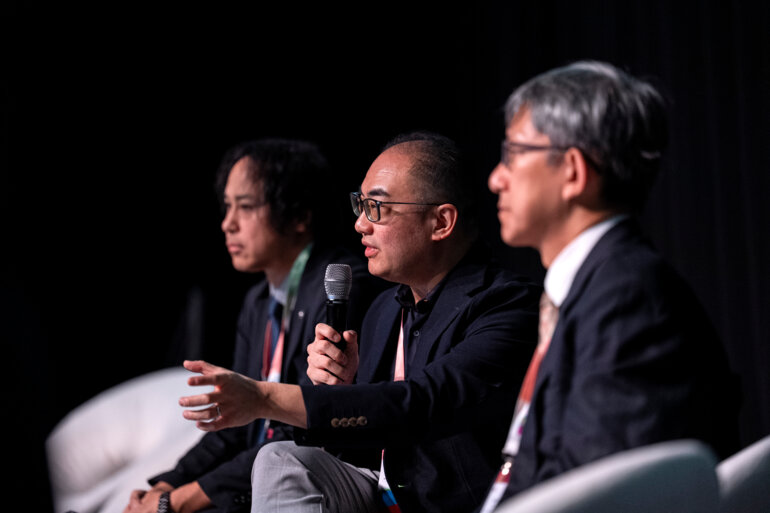Extensive research identified the deficiency of a highly accurate DNA repair process known as homologous recombination as an ‘Achilles heel’ in cancer, and led to the development of PARP inhibitors as single-agent therapies
Genetic defects that prevent a cell’s DNA repair systems from functioning increase susceptibility to cancer. Such defects can also be considered the tumour’s ‘Achilles heel’ or potential weakness that may be targeted by treatment.
The homologous recombination (HR) repair process, a specific type of DNA repair mechanism that healthy cells use to maintain an accurate genetic code, is controlled by ‘housekeeping’ genes such as BRCA1/2. Defects in HR lead to mutations – errors in the genetic code – and result in cancer when the genetic code instructs the cell to grow in an uncontrolled manner and resist death, creating aggressive forms of breast, ovarian, prostate and pancreatic cancers. By targeting a DNA repair process required by the HR-deficient tumour, and trapping a protein named PARP1 on DNA, PARP inhibitors prevent such cancers from growing and cause them to die (Nature. 2005;434:917–921; Nature. 2005;434:913–917).
PARP inhibitors have proven to be very successful in the treatment of specific cancers (Ann Oncol. 2019;30:1437–1447); initially, they were evaluated and proved efficacious in types of ovarian cancer characterised by an inherited mutation of the BRCA1/2 genes (N Engl J Med. 2012;366:1382–1392), or genomic instability signatures associated with failure of function of these HR genes (N Engl J Med. 2016;375:2154–2164; Lancet Oncol. 2017;18:1274–1284; N Engl J Med. 2018;379:2495–2505). Their use then extended to ovarian cancer outside those associated with such signatures (N Engl J Med. 2019;381:2391–2402), and to use in combination with other licensed therapies in ovarian cancer (N Engl J Med. 2019;381:2416–2428). PARP inhibitors have demonstrated efficacy in other inherited cancers, such as breast cancer with germline mutations in BRCA1/2 genes (N Engl J Med. 2017;377:523–533), pancreatic (N Engl J Med. 2019;381:317–327) and prostate cancers (N Engl J Med. 2020;382:2091–2102; N Engl J Med. 2023;388:719–732) with mutations in HR DNA repair genes, and most recently in combination with next-generation anti-androgen therapies (NEJM Evid. 2022;1:EVIDoa2200043; Lancet. 2023;402:291–303; Nat Med. 2024;30:257–264).
In patients with BRCA1/2-mutated early breast cancer treated in the phase III OlympiA trial, the addition of a PARP inhibitor (olaparib) to chemoradiotherapy following surgery was associated with improved survival compared with placebo (N Engl J Med. 2021;384:2394–2405; Ann Oncol. 2022;33:1250–1268). This is one of very few drugs to show improved survival compared with chemotherapy in breast cancer (another example is the HER2-targeted therapy trastuzumab).
Laboratory experiments comparing cells with a defective or competent HR process have shed some light on the mechanisms by which cancer cells evade the effects of PARP inhibitors and become resistant. The most common mechanism is via the ‘quick and dirty’ ‘end-joining’ DNA repair that occurs when HR is deficient, leading to a somatic ‘reversion’ mutation of the BRCA gene in the tumour. This removes the effect of the inherited mutation and restores the wild-type function of the gene, thus effectively eliminating the tumour’s ‘Achilles heel’ and making the cancer cell resistant to treatment (Nature. 2008;451:1111–1115; Nature. 2008;451:1116–1120; Cancer Discov. 2020;10:1475–1488). Other resistance mechanisms are thought to occur through ‘rewiring’ of DNA repair mechanisms to turn HR back on, even in the presence of a faulty BRCA gene, for example through loss of 53BP1 protein (Cancer Discov. 2013;3:68–81). This topic is further explored by Dr Alan D'Andrea (Boston, MA, USA), who reviews new therapeutic approaches beyond PARP inhibition that exploit HR deficiency and specifically target resistance mechanisms, in his part of our linked Keynote lectures on this theme at the ESMO Congress 2024 (Barcelona, 13–17 September).
Recent studies have been investigating potential methods to identify patients who are at risk of becoming resistant to PARP inhibitors, including detection of both BRCA1/2 reversion and 53BP1 mutations, either by DNA sequencing of the tumour tissue or by sequencing of circulating tumour DNA in plasma (Ann Oncol. 2024;35:364–380). Preliminary data suggest that the presence of a reversion mutation prior to starting treatment may be predictive of poor or no response to PARP inhibitor therapy.
Currently, there is no proven intervention to prevent the development of resistance to PARP inhibitors. We need to understand which of our standard-of-care treatments potentially accelerate the development of resistance to these agents and whether different treatment schedules or combinations of therapy could delay or prevent resistance from occurring. This is a very active area of preclinical and clinical research and is the focus of a huge global team effort.
As PARP inhibitors have been used with much success in treating inherited cancers once they have developed, it is tempting to speculate whether they could be used as a preventative therapy, for example in young women with a mutated BRCA1/2 gene who are at high risk of developing breast or ovarian cancer. A PARP inhibitor could potentially eradicate cancer cells at a very early stage of disease development, but these agents are not without side effects, especially if given for prolonged periods. Therefore, a cautious approach would be needed to determine if they are active in this setting, the schedule required to achieve this and any associated risks of treatment in individuals who do not have cancer. There are still a number of questions to answer before a primary prevention study would be feasible, although the long-term effects of olaparib on second breast and ovarian cancers in those who retain their breasts and ovaries are under investigation in the OlympiA trial (Ann Oncol. 2022;33:1250–1268).
Current and future studies will look at how PARP inhibitors could potentially be used at an even earlier stage in breast or ovarian cancer treatment to prevent recurrence and improve survival. In addition, the field will be investigating other known epigenetic mechanisms of silencing BRCA1 and RAD51C genes that turn off the HR repair process, to identify which of the resulting cancers are sensitive to PARP inhibition at early stages of disease. Thus, we are exploring how we can extend the principle of targeting the ‘Achilles heel’ so that a broader group of people can benefit from PARP inhibitors in the future.
Programme details
Tutt AN. DNA repair pathways: Leveraging science in order to exploit the tumour Achilles heel – A journey of discovery and perseverance. Team science to find and target an “Achilles heel” through PARP inhibition. ESMO Congress 2024
Keynote Lecture, 14.09.2024, h. 12:05 – 12:35, Madrid Auditorium – Hall 2
D’Andrea A. DNA repair pathways: Leveraging science in order to exploit the tumour Achilles heel – A journey of discovery and perseverance. Beyond PARP inhibition: New preclinical science entering the clinic. ESMO Congress 2024
Keynote Lecture, 14.09.2024, h. 12:05 – 12:35, Madrid Auditorium – Hall 2







